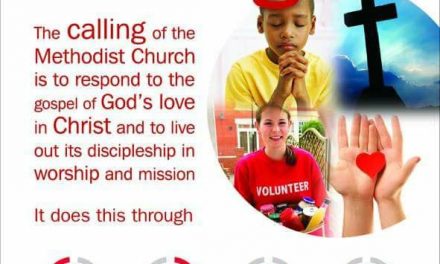Luke is the only writer in the Bible to use the word manger in the New Testament. He tells us that when Jesus was born, Mary laid Him in something called a Manger, the Latin word munducare, which means “to eat” (Lk 2:7). Luke, in the most famous Christmas paragraphs in the Bible, points our attention to the Manger three times: “She gave birth to her firstborn son and wrapped him in swaddling cloths and laid him in a manger because there was no place for them in the inn” (Lk 2:7); “This will be a sign for you: you will find a baby wrapped in swaddling cloths and lying in a manger” (Lk 2:12); “They went with haste and found Mary and Joseph, and the baby lying in a manger” (Lk 2:16). Manger which comes from the word – chew or eat is a missional metaphor, a sign, a symbol and a call to discipleship in a trough that saves and make us leap for hope, peace, love, and joy (Lk 13:15).
Jesus Christ, through the Holy Spirit, made of a woman, and of that woman which Himself made was the child in the womb bigger and greater than the mother. The angels appeared to the shepherds in the field to look for a baby in a Manger. This is too good to be true, even in our modern context. For the shepherds to believe and bear witness to what the angels said, they need a sign. It is not a sign only to the shepherds but to all of us today that Jesus is accessible to everyone who seeks Him in truth and spirit.
The Manger, as a missional sign and metaphor, is about accessibility to Jesus, the bread of life; hence, all can be saved. Just as the sign is the Manger, the swaddling clothes are not just survival or winter kits. Clothing can insulate against cold or hot conditions. Clothing can provide a hygienic barrier, keeping infectious and toxic material away from the body. Mary’s swaddling clothes around Jesus suggest that Jesus was properly cared for and not exposed to the spiritual toxic, redefinitions, and calculations. The lack of swaddling as an allegorical description in the Book of Ezekiel suggests ‘a sure sign that the baby had been legally abandoned and could be claimed’ (Ezk. 16).
Luke’s inclusion of the swaddling clothes in his infancy narrative beyond maternal care and concern warns that no other claims or expression can change the reason, meaning, and significance of our Saviour’s birth. In the words of Thomas Watson, Jesus’ lay in the manger’ wrapped from the ungodly influence of the world ‘that we may lie in paradise.’
The Manger, beyond royalty in a feeding trough for animals, is the way of discipleship (Jn 6:35, 51. The angels told the shepherds to look for a baby “wrapped in swaddling clothes.” The angels did not speak to Pharisees. The Lord of heaven ‘have hidden these things from the wise and understanding and revealed them to little children,’ the disciples in their humility and simplicity (Lk. 10:21). The shepherds, who were first to hear the Good News of Jesus’ birth provides us a model of discipleship, not just because of their low cultural status but with warmed hearts and spiritual vigilance.
Pope Benedict XVI, in his Christmas Homily, 2009, on the shepherds’ vigilance, said, “The principal difference between someone dreaming and someone awake is that the dreamer is in a world of his own. His “self” is locked into this dreamworld that is his alone and does not connect him with others. To wake up means to leave that private world of one’s own and enter the common reality, the truth that alone can unite all people … Awake, the Gospel tells us. Step outside so as to enter the great communal truth, the communion of the one God. To awake, then, means to develop a receptivity for God: for the silent promptings with which he chooses to guide us; for the many indications of his presence … Our way of thinking and acting, the mentality of today’s world, the whole range of our experience is inclined to deaden our receptivity for God, to make us “tone deaf” towards him. And yet in every soul, the desire for God, the capacity to encounter him, is present, whether in a hidden way or overtly.” The church requires such shepherds and Saviour today when many are determined to run in the opposite direction while trying to drag everyone along with them,’ self-locked in their love dreamworld and deadened receptivity for God and His Word.
In his 2009 Christmas Eve Homily, Pope Benedict explained that, ‘The story of the shepherds is included in the Gospel for a reason: they show us the right way to respond to the message that we too have received.” The shepherd, as faithful disciples, went in haste and found Mary and Joseph. No debates or committee meetings to decide when who, and how to go. They went in haste and found the infant lying in the Manger. They made known the message that had been told them about the child (Lk 2: 8-20). The Manger, as a way of discipleship through the shepherds, teaches us missional priority beyond any other matters. The shepherds opened eyes of faith, coupled with their warmed hearts, saw a newborn child wrapped in swaddling clothes. They were contented, with no debate on the mystery of God-made-man. The shepherds, as faithful disciples, allowed God’s signs to shape them in humility and simplicity to fulfill the mystery of Christmas.
Beloved, God still sends angels to shepherds, not to kings. The shepherds are those abiding in the field. They kept watching over the lambs by night and day for oversight and provision of the lambs for the atonement of sin. A flawed lamb is unacceptable as an offering to God. With the shepherds’ opened eyes of faith and warmed hearts, and in obedience to the command of the angels, the shepherds did not only see the spotless Lamb wrapped in human flesh, and they saw the Lamb of God that takes away the sin of the world.











Recent Comments